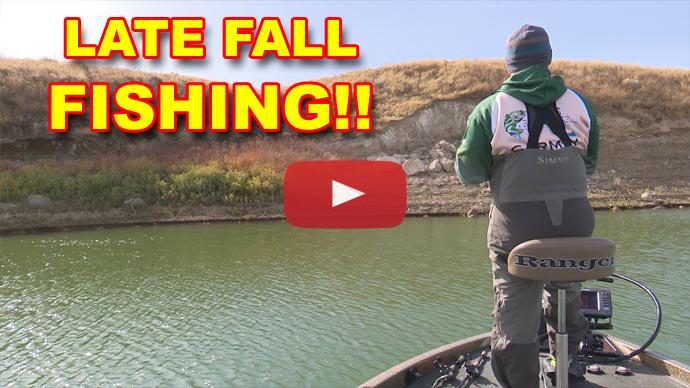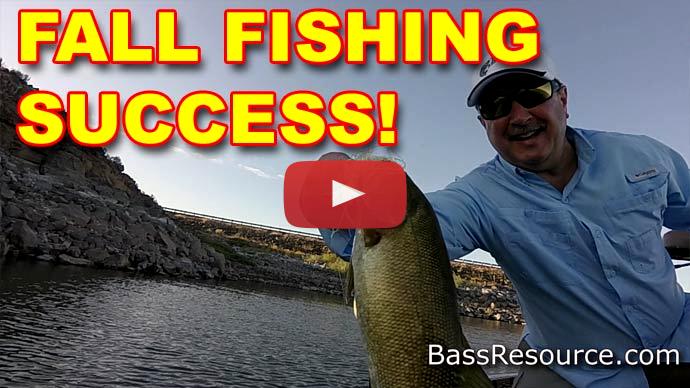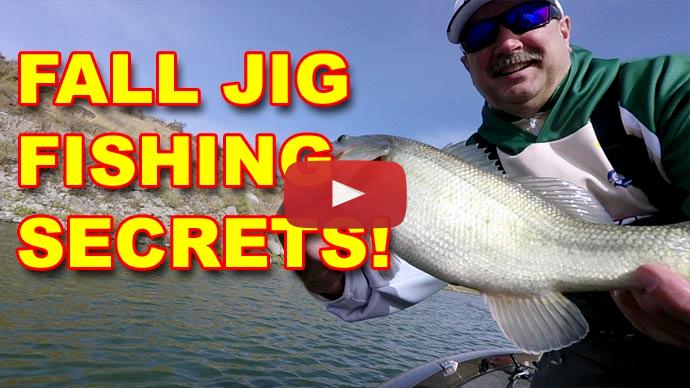Hey, folks, Glenn May here with BassResource.com. And today I wanna talk to you about a question that I get fairly often. And that is if you're in a brand new body of water, how do you go about finding fish and what lures do you use? So I wanna talk about since it's fall, I wanna talk about specifically, how do you find fish on a brand new body of water during the fall and what lures to use.
So I wanna talk...first of all, before I get into lures, I wanna talk about my approach. When it comes to fall fishing, a brand new lake, as soon as I launch the boat one of the first things I do is I beeline it right to the first point, the nearest point I can find. Now the reason for that is all throughout the summer, spring, and into fall tournaments are being held and typically the weigh-ins are right there at the ramp, and a lot of people release their fish right there.
Well, the closest structure is that point. So I'll go right to it. And a lot of fish will go there, they'll set up shop for a little while, and then they'll disperse throughout the rest of the lake and some of them will stay there. But these are fish that have already been caught, which means they have a propensity to bite. So the nearest point, by a launch, can be very productive. A lot of people blow right on by it because it's too close to the launch, and they think it gets overfished, oftentimes it's not.
So that's the first thing I'll do, a brand new lake I haven't been to, I'm gonna find a point. And the thing I wanna do is I wanna figure out what depth they're at and what's their disposition. And I kind of think about with the fall, there's this migration that happens. So I think about what period in the fall are you at? In the early fall, the fish will start to move shallow, chasing baitfish and feeding up heavy, getting ready for the winter.
So the bulk of the population is going to be in that 1-to-10 foot range. Whereas you get late in the fall, these fish will be moving out deeper. So now they'll be deeper than 10 feet, you know, 5, nearly 10, 10 to 25 feet, especially as you get closer to winter, they're gonna be closer to that 25-foot zone.
So I'll hit that point relative to where we are in the season. If it's early on in the fall, I'm gonna start off shallow and fish deep, whereas if it's mid to late fall, I'm gonna start deep and work my way up shallower to try to figure out what depth those fish are holding at.
And I'm attacking with several different lures with different approaches and speeds to figure out what their disposition is.
Another thing I take into consideration is the fronts. During the early fall, fronts don't have so much of an impact on the bass, but later on in the fall you usually have larger fronts, and a big front that blows through has a chance of shutting down the bite or at least making them sink a little bit lower, a little bit deeper, and hugging that cover a little bit more. So you got to think about what lures to use if the fish may be doing that.
So with that in mind, let's get into the five lures that I use, starting with the Yum Dinger. I really like using the Yum Dinger. Some people like to use a Senko. I like to use a Yum Dinger because it's more durable. But I like it because it's so flexible. You can use it in a variety of different conditions in different depths. Early in the fall when the fish are shallow I just simply rig it weightless, and throw it out there and at any kind of cover that they may be at.
It could be docks, it could be rocks, it could be logs, any kind of...you know, flats where there's grass, any place where they could be chasing those baitfish that's where I wanna throw that Yum Dinger and just throw it out and let it fall on slackline, so it falls horizontally. And a lot of times, that's how you get bait is that presentation.
That's all there is to it. You don't have to do anything else, really. It's an easy bait to use. Although I like to skip it under docks, especially in the early fall and into mid-fall when the fish are shallow. You can get back in there where those fish are and put it right on their face. So that could be a lot of fun.
But as fall progresses and the fish start to move deeper, now I can bring it on a drop shot, or a split-shot, or even a Carolina rig to get that bait down there and still get to those fish with a Yum Dinger and get those bites to continue on throughout the fall. And you can fish it into any kind of speed with those rigs. You can, with a drop shot, you can just let it sit there in place or you can jig it just a little bit to give it a little bit of action, just let it sit in place. You can also drag it just a little bit and move it.
With the split-shot, what I like to do is I like to lift it up a little bit, pull it in and let it drop. What it does, the weight comes up and brings that Yum Dinger behind it, the weight drops, and then the Yum Dinger does that fall. And that's usually how you get that bite.
So you still have that action, but now you're in 15 or 20 feet of water. You don't have to wait for it to get down there. Just use a split-shot to get it down there, and then you can work it that way. So really good, versatile, lure to use. You can cover the whole water column and the different speeds throughout the fall.
Now the next lure I like to use is very similar reasons is the jig. The jig, again, can be fished at all depths, and at different speeds. Early in the fall, I'll use a 3/8-ounce jig and I'm gonna throw it around all that kind of cover that I just mentioned. I love to throw out next to docks, a 3/8-ounce jig, just let it slowly fall next to it along weed lines. These fish will get up in the weeds, and I find that weed line, that edge, and drop it right along that edge, and those fish that are cruising the edge looking for baitfish will snatch it up before it hits the bottom.
As fall progresses, and they start to get deeper, I'll still use a 3/8-ounce jig. It works really well on those deeper weed beds, and especially where there's any kind of rocks or logs along them. But I'll also get a little bit heavier, too, when the wind picks up so it can maintain contact. It's kind of hard to maintain contact with a 3/8-ounce jig in 20 feet of water when the wind's blowing. So if it gets a little bit strong out there, I'll use it at 1/2 ounce, maybe at a 3/4 ounce, and I'll flip over to a football head jig as it gets down away from the weeds.
Later in the fall when they're just in the structure and there's not a lot of weeds on them, a football head jig works really well, like over the tops of humps, or in the middle of creek channels, or those drop-offs, or deep points. Let it fall, get to the bottom, and then slowly work it, slowly. And what happens with that football jig as you pull it through on the bottom it wobbles back and forth.
It looks like a little crawdad, just making its way along, very vulnerable, lonely, unsuspecting crawdad, and bass can't resist that. So it's a great way to fish the different depths, and also when the fish are..you've got these big fronts that have come through and they're not willing to bite so much, a jig is really good bait to use. So use a jig, definitely use that.
Now, my next bait that I really like to use during the fall and depending on what, again, lake I'm on, but usually a 6-inch paddle tail swimbait works really well because the fish are gorging on baitfish. So it's a great time to use it during the fall, and I use it kind of as a search bait when trying to find fish. You can fish it up shallow and you can run it through any kind of cover, any kind of depth using just a 1/4-ounce keel-weighted hook and Texas rig it, and now I can throw it into anything and not worry about getting it hung up.
But along docks works really well. You can bring along those weed edges and just kill it and let it flutter down. There's a lot of different ways you can fish it. And especially as it gets deeper in the fall, I just add the weight a little bit. I'll put a 3/8-ounce weight onto it, maybe 1/2 ounce, as it gets deeper and deeper. And I can still work it the same way in those fish that are focusing on baitfish will clock it.
One little tip, it's a great way to fish suspending fish. That is when you've got schools of baitfish, especially in the late part of the fall, when perch will be in big balls, shad will do this too sometimes, they'll be kind of off, maybe offshore a bit, maybe hanging out over 40, 50 feet of water. But they'll be within 10 feet or so, 15 feet, of the surface.
If you look on your depth finder and you see that there's a nice tight ball, then that means they're protecting, know, they're being herded or attacked by prey fish, typically bass. If it's a big loose ball, then there's usually aren't any bassline nearby. So pay attention how tight that ball is. If it's nice and tight, I'll take that paddle tail swimbait, 1/4-ounce, even though I'm in deep water, and I wanna throw it right over the top of that baitfish ball and just let it fall right through it.
When it comes out near the bottom, it looks like a baitfish that's dying, and that's what the bass are keying on and pow. It's a great way to catch bass. Now if you're throwing in perch, it may be a little difficult because perch love plastics. So they may nip and bite it a little bit so you may have to resist setting the hook till you really feel that good wait on it, that it's a bass, and then set the hook. But great way to fish balls of fish, baitfish in the late fall.
Now I'd be remiss to go to a brand new lake during the fall if I didn't have a spinnerbait tight on, because a spinnerbait to me is really a great lure to use during the fall because it mimics baitfish, which is exactly what the fish are keying on. Not only that, though, spinnerbaits can be fished in all depths of water in different speeds.
So in the early fall when the fish are up shadow, I'll use a 3/8-ounce spinnerbait with a willow leaf blade because it gives off the profile and flash of baitfish. And again, I'll throw it around anything that I can see visible cover, weed, docks, rocks, logs, chunk rock, big flats. Those are the things that those fish are keying on during this time of year.
Then you get into mid to late fall and these fish start to pull off in those deeper weed beds. That's when I'll heavy up a little bit, about a 1/2-ounce, and later on even a 3/4 ounce, put on maybe Colorado blades so I can get it down there and work it a bit slower right along those weed edges or the tops of those deep weed beds. Those humps can be really good this time of year.
And also when the fish...sometimes when, in the late fall, you got a big front that comes through and they tend to hunker down in the middle of those creek channels, it's a great time to drag and slow roll a 3/4-ounce spinnerbait through them and catch them that way. Even when they get deep, you can let it flutter down, the, helicopter down right to the base of a point or base of a hump, and work it nice and slow, pump it up and down through that way and let it flutter again.
Those fish tend to be keying on dying bass fish, so bringing it up and let it fall back down, that pumping action, resembles a baitfish that's struggling to stay upright. Great way to catch fish in the fall. So spinnerbait, you definitely got to have tied on.
And finally my fifth bait, not last or least, but it just happens to be the last in the list is a frog. Now, frog admittedly isn't as good to use later in the fall when the fish are deeper. But, boy, in early to mid frog season...early to mid-fall season, I can almost call it a frog season, because that to me is like the best time to be throwing a frog throughout the entire year. Bar none, even during the summer and in the spring when frogs work really well, topwater frog action in the fall, there's none other like it. It is a blast, and you've got to have a frog tied on.
Now, you can fish in a variety of ways. If the fish are very active, you can walk the dog and cause quite a bit of commotion. I like to plop it along really quick, just fast cadence, it's real quick, pop, pop, pop, pop, pop, pop, pop, and make a lot of noise and sputter it along, and get a lot of fish's attention that way. I bring it over the top of those weeds, right next to those logs, and then right alongside docks.
Great way to go after those aggressive fish and the strikes are ferocious. But even as you move a little bit more towards mid-fall, those fish are gonna get more into those weeds in those weed beds and you can bring it over the tops of those weeds without worrying about getting hung up and you can slow it down. So you can work it a lot more methodically.
The fish may be a little more reluctant to rise to topwater bait, but if you can make it look like something that's struggling on the surface because a frog floats and you can sit there in place and just barely pop it and barely move it, make it look like something that's struggling, those fish will rise up and hit it that way.
So it can be very, very effective and a real fun way to catch fish is using frogs during the fall, especially in a new body of water. You feel like you just triumphed. It can be a great way to find all those fish.
So those are my top fish finders in the fall. I hope that works. For more tips and tricks like that visit BassResource.com.



